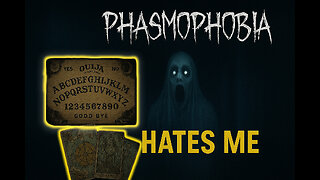Premium Only Content

The Japan that no one knows. Bad writing, 30 years of underachievement, hit maker of stories at 50
#Japan
#Tokyo
#Japanese
Healing Japan Travel
日本語バージョンはこちら Click here for the Japanese version
https://youtu.be/iKaOv7N7p34
Tokyo Shrines with Pictures of Japanese People 100 Years Ago
Kurofune Inari Shrine
This is another small Inari shrine that sits between houses.
This deity was familiar to the common people of the Edo period and was mentioned in Yumie Hiraiwa's Edo novels.
Why did Tsuruya Nanboku live here?
We did not know,
A doctor who examined Soji Okita lived in Imado Shrine, and it must have been quite common for people to live in shrines in the past. I envy him a little.
Tsuruya Nanboku is a hit maker of stories, a publicist, and a great producer, who made it big after a mind-boggling 30 years of working under the table.
In this way, for him, the 30 years of underachievement was truly a source of sustenance. I wonder how he was able to endure that period of time.
Kurofune Inari Shrine Neighborhood
1 min. on foot Osan Inari Shrine
5 minutes on foot Suisei Inari Daimyojin
5 minutes on foot Peony Sumiyoshi Shrine
8 minutes on foot Tomioka Hachimangu Shrine
9 minutes on foot Hojoin Fukagawa Enmadoh
10 minutes on foot Fukagawa Fudo Hall (Naritasan Tokyo Betsuin)
18 minutes on foot Takao Inari Shrine (Shrine dedicated to prostitute Takao Tayu)
19 minutes on foot Sumiyoshi Shrine
19 minutes on foot Shinkawa Grand Shrine
19 minutes on foot Kiba Suzaki Shrine
24 minutes on foot Hibiya Inari Shrine
25 minutes on foot Fukagawa Shinmei-gu Shrine
25 minutes on foot Nihonbashi Hie Shrine
25 minutes on foot Suitengu Shrine
26 minutes on foot Shiomi Jizoson
26 minutes on foot Teppozu Inari Shrine
27 minutes on foot Shinto Taikyo Ginko-Hachimangu and Ginko-Inari
28 minutes on foot Ohara Inari Shrine
28 minutes on foot Chanoki Shrine
28 minutes on foot Hamacho Shrine
29 minutes on foot Matsushima Shrine
29 minutes on foot Koami Shrine
29 minutes on foot Kabuto Shrine
When we visit shrines in Tokyo, we are often amazed at the sanctuaries that have been protected by the people.
Flood, fire, earthquake, war, and worship.
Small shrines, shrines perched on the rooftops of buildings, and shrines directly under expressways.
Sanctuaries that are close to people in any form, and the guardians who protect them.
I made this video to share these beautiful images with you!
The Japanese landscape and the Japanese people of the past remain in old photographs.
Some of the photos are around 100 years old, some are about 150 years old, and some are 85 years old.
Please feel the connection with the people of the past!
Source
BAKUMATSU BOYS -- Brother Teaches Brother to Write, While Little Sister Looks On in Old Japan.
https://www.flickr.com/photos/okinawa-soba/2365240256/in/album-72157605137046347/
FOUR GEISHA PRACTICE THEIR ROUTINE.Ca.1897-1900 T. ENAMI Glass Slide from a Stereoview.Okinawa Soba (Rob)
Okinawa Soba (Rob) https://www.flickr.com/photos/okinawa-soba/3286613372/in/album-72157613976400352/
SHASHAMI-EMI-zu 3-kan" by Kyoden and others, 12p, [Tsutaya Jyuzaburo],[Kansei 3(1791)]. National Diet Library Digital Collections
Created by processing [Tokaido Yotsuya Kaidan] 4300639031 (Tokyo Metropolitan Library)
[Kana Soga Touhorai] (Tokyo Metropolitan Library)
Created by processing [Tokaido Yotsuya Ghost Story] (Tokyo Metropolitan Library)
[Ukiyoe Hiyou Inazuma] (Tokyo Metropolitan Library)
BGM
Japanese Shoka "Furusato" moving Koto and chorus Free BGM Discovery Site - Tono's Precious Treasure House
Hometown (Furusato)
A Japanese children's song and shoka with music by Teiichi Okano and lyrics by Tatsuyuki Takano.
It is a shoka published by the Ministry of Education in 1914 for the sixth grade of "Shoka for Elementary School Children".
Rabbit Oshikishi Kano-no Yama (The Rabbit Chases the Mountain)
Fishing for crucian carp, the river of Kano
Yume ha mondemo megurite
"I'll never forget my hometown."
How are your parents?
Tsutsugami-no-shinai ya tomogaki (Tsutsugami-no-shinashi, Tomogaki)
"Even in the rain and wind..."
I remember my hometown.
"I will follow my heart."
Someday I will return home.
Mountains are blue, my hometown.
The water is clear.
Yuyake Koyake Koyake" (Sunset Sunset Sunset)
A Japanese children's song and shoka with lyrics by Ameko Nakamura and music by Makoto Kusakawa.
Lyrics written in 1919, music composed in 1923 (one month before the Great Kanto Earthquake).
My name is Mayu Noda.
I will introduce the charm of shrines around Tokyo, which I love.
Sometimes temples too.
Please subscribe to our channel.
Inside Japan's Coolest Shrine
https://www.youtube.com/watch?v=siS4puFCoDk
Travel to Nagano #1☆ Visit all 5 Togakushi shrines!! Japan vlog
https://www.youtube.com/watch?v=e9SPkyBNk2g
TOKYO AT NIGHT 🇯🇵 | Meiji Jingu Shrine | Tokyo Travel Vlog
https://www.youtube.com/watch?v=HTiI_AI_RzQ
Walk in Kyoto, Japan | Kyomizu Temple
https://www.youtube.com/watch?v=g0aWmu_PhlA
Japan in 8K ULTRA HD - Land of The Rising Sun (60 FPS)
https://www.youtube.com/watch?v=G5RpJwCJDqc
-
 2:04:10
2:04:10
Inverted World Live
7 hours agoJapanese Memory Eraser | Ep. 101
67.9K17 -
 2:42:52
2:42:52
TimcastIRL
4 hours agoTrump To Deploy National Guard To Chicago, Baltimore, Democrats Call To Resist | Timcast IRL
202K47 -

Laura Loomer
6 hours agoEP141: Muslims Call For Political Assassinations At Michigan Palestinian Conference
31.6K24 -
 4:39:32
4:39:32
Barry Cunningham
6 hours agoBREAKING NEWS: PRESIDENT TRUMP IS GOING TO TAKE CHICAGO! LFG!!! (IT'S MOVIE NIGHT!)
79.8K51 -
 1:23:59
1:23:59
Man in America
8 hours agoTrump Demands Big Pharma Come Clean on Covid Shots w/ Dr. David Martin
34K22 -
 1:40:27
1:40:27
megimu32
4 hours agoOTS: Labor Day Sitcom Blowout - Tim, Ray, & Relatable Chaos!
30K2 -
 DVR
DVR
StevieTLIVE
4 hours agoWarzone Wins w/ FL Mullet Man
24.5K1 -
 1:04:01
1:04:01
BonginoReport
7 hours agoLefties Wish Death on Trump but He’s BACK! - Nightly Scroll w/ Hayley Caronia (Ep.125)
183K83 -
 3:18:28
3:18:28
Tundra Tactical
4 hours ago $0.51 earnedWe Survived the Military… But Not This Basement
27.8K -
 20:12
20:12
Clownfish TV
12 hours agoDisney Needs MEN Back?! They ADMIT Star Wars and Marvel are DEAD!
23.7K35